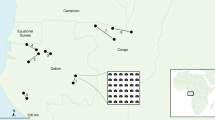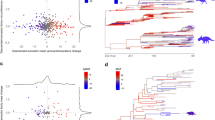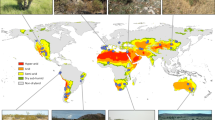Abstract
The domestication of cattle, sheep and goats had already taken place in the Near East by the eighth millennium bc1,2,3. Although there would have been considerable economic and nutritional gains from using these animals for their milk and other products from living animals—that is, traction and wool—the first clear evidence for these appears much later, from the late fifth and fourth millennia bc4,5. Hence, the timing and region in which milking was first practised remain unknown. Organic residues preserved in archaeological pottery6,7 have provided direct evidence for the use of milk in the fourth millennium in Britain7,8,9, and in the sixth millennium in eastern Europe10, based on the δ13C values of the major fatty acids of milk fat6,7. Here we apply this approach to more than 2,200 pottery vessels from sites in the Near East and southeastern Europe dating from the fifth to the seventh millennia bc. We show that milk was in use by the seventh millennium; this is the earliest direct evidence to date. Milking was particularly important in northwestern Anatolia, pointing to regional differences linked with conditions more favourable to cattle compared to other regions, where sheep and goats were relatively common and milk use less important. The latter is supported by correlations between the fat type and animal bone evidence.
This is a preview of subscription content, access via your institution
Access options
Subscribe to this journal
Receive 51 print issues and online access
$199.00 per year
only $3.90 per issue
Buy this article
- Purchase on Springer Link
- Instant access to full article PDF
Prices may be subject to local taxes which are calculated during checkout




Similar content being viewed by others
References
Clutton-Brock, J. A Natural History of Domesticated Mammals (Cambridge Univ. Press, 1999)
Ducos, P. Proto-élevage et Élevage au Levant Sud au VIIe Millénaire B.C. les Données de la Damascène. Paléorient 19, 153–173 (1993)
Garrard, A., Colledge, S. & Martin, L. in The Origins and Spread of Agriculture and Pastoralism in Eurasia (ed. Harris, D. R.) 204–226 (University College London Press, 1996)
Sherratt, A. in Patterns of the Past. Studies in Honour of David Clark (eds Hodder, I., Isaac, G. & Hammond, N.) 261–305 (Cambridge Univ. Press, 1981)
Sherratt, A. The secondary exploitation of animals in the Old World. World Archaeol. 15, 90–104 (1983)
Dudd, S. N. & Evershed, R. P. Direct demonstration of milk as an element of archaeological economies. Science 282, 1478–1481 (1998)
Copley, M. S. et al. Direct chemical evidence for widespread dairying in prehistoric Britain. Proc. Natl Acad. Sci. USA 100, 1524–1529 (2003)
Copley, M. S. et al. Dairying in antiquity: III — Evidence from absorbed lipid residues dating to the British Neolithic. J. Archaeol. Sci. 32, 523–546 (2005)
Copley, M. S. et al. Processing of milk products in pottery vessels through British prehistory. Antiquity 79, 895–908 (2005)
Craig, O. E. et al. Did the first farmers of central and eastern Europe produce dairy foods? Antiquity 79, 882–894 (2005)
Kohler-Rollefson, I. in Pastoralism in the Levant: Archaeological Materials in Anthropological Perspective (eds Bar-Yosef, O. & Khazanov, A.) 11–18 (Monographs in World Archaeology, 1992)
Levy, T. E. The emergence of specialized pastoralism in the southern Levant. World Archaeol. 15, 15–36 (1983)
Bogucki, P. I. Ceramic sieves of the linear pottery culture and their economic implications. Oxf. J. Archaeol. 3, 15–30 (1984)
Payne, S. Kill-off patterns in sheep and goats: The mandibles from Aşvan Kale. J. Anatol. Stud. 23, 281–303 (1973)
Legge, A. J. in Farming Practice in British Prehistory (ed. Mercer, R.) 169–181 (Edinburgh Univ. Press, 1981)
Grigson, C. in Archaeology of Society in the Holy Land (ed. Levy, T. E.) 245–268 (Leicester Univ. Press, 1995)
Christie, W. W. Lipid Metabolism in Ruminant Animals 203–226 (Pergamon, 1981)
MacDonald, P., Edwards, R. A. & Greenhalgh, J. F. D. Animal Nutrition (Longman, 1988)
Evershed, R. P. et al. Formation of long-chain ketones in ancient pottery vessels by pyrolysis of acyl lipids. Tetrahedr. Lett. 36, 8875–8878 (1995)
Evershed, R. P., Vaughan, S. J., Dudd, S. N. & Coles, J. S. Fuel for thought: Beeswax in lamps and conical cups from Late Minoan Crete. Antiquity 71, 979–985 (1997)
Hansel, F. A., Copley, M. S., Madureira, L. A. S. & Evershed, R. P. Thermally produced ω-(o-alkylphenyl)alkanoic acids provide evidence for the processing of marine products in archaeological pottery vessels. Tetrahedr. Lett. 45, 2999–3002 (2004)
Richards, M. P., Pearson, J. A., Molleson, T. I., Rusell, N. & Martin, L. Stable isotope evidence of diet at Neolithic Catalhöyük, Turkey. J. Archaeol. Sci. 30, 67–76 (2003)
Faquhar, G. D., Ehleringer, J. R. & Hubrick, K. T. Carbon isotope discrimination and photosynthesis. Annu. Rev. Plant Physiol. Plant Mol. Biol. 40, 503–537 (1989)
Boessneck, J. & von den Driesch, A. Die Tierknockenfunde aus der Neolitischen Siedlung auf dem Fikirtepe bei Kadıköy am Marmaramee (Institut für Palaeoanatomie, Domestikationsforschung und Geschichte der Tiermedizin, Universität München, 1979)
Russell, N. & Martin, L. in Inhabiting Çatalhöyük: Reports from the 1995–99 Seasons (ed. Hodder, I.) 33–98 (McDonald Institute Monographs/British Institute of Archaeology, 2005)
Mukherjee, A. J., Berstan, R., Copley, M. S., Gibson, A. M. & Evershed, R. P. Compound-specific stable carbon isotope detection of pork consumption applied to the British Late Neolithic. Antiquity 81, 743–754 (2007)
Dudd, S. N., Regert, M. & Evershed, R. P. Assessing microbial lipid contributions during laboratory degradations of fats and oils and pure triacylglycerols absorbed in ceramic potsherds. Org. Geochem. 29, 1345–1354 (1998)
Aillaud, S. Field and Laboratory Studies of Diagenetic Reactions Affecting Lipid Residues Absorbed in Unglazed Archaeological Pottery Vessels. PhD thesis, Univ. Bristol (2000)
Charters, S., Evershed, R. P., Goad, L. J., Blinkhorn, P. W. & Denham, V. Quantification and distribution of lipid in archaeological ceramics: Implications for sampling potsherd for organic residue analysis. Archaeometry 35, 211–223 (1993)
Mukherjee, A. J., Copley, M. S., Berstan, R. & Evershed, R. P. in The Zooarchaeology of Fats, Oils, Milk and Dairying (eds Mulville, J. & Outram, A. K.) 77–92 (Oxbow Books, 2005)
Acknowledgements
We thank the Leverhulme Trust for their support (F/00182/T), and the UK Natural Environment Research Council for mass spectrometry facilities.
Author Contributions R.P.E., A.G.S. and S.P. conceived and planned the project. R.P.E. and S.P. wrote the paper. M.S.C., J.C. and D.U.-K. undertook sampling, analytical work and data analysis. All other authors either directed excavations or provided expertise in relation to pottery and/or faunal collections and essential insights into the study region and sites.
Author information
Authors and Affiliations
Corresponding author
Rights and permissions
About this article
Cite this article
Evershed, R., Payne, S., Sherratt, A. et al. Earliest date for milk use in the Near East and southeastern Europe linked to cattle herding. Nature 455, 528–531 (2008). https://doi.org/10.1038/nature07180
Received:
Accepted:
Published:
Issue Date:
DOI: https://doi.org/10.1038/nature07180
This article is cited by
-
Estimating the Ontogenetic Age and Sex Composition of Faunal Assemblages with Bayesian Multilevel Mixture Models
Journal of Archaeological Method and Theory (2023)
-
New insights into the subsistence strategies of the northwest frontier of the Western Zhou Dynasty (1046–771 BCE) through pottery lipid analysis
Archaeological and Anthropological Sciences (2023)
-
Diversified pottery use across 5th and 4th millennium cal BC Neolithic coastal communities along the Strait of Gibraltar
Archaeological and Anthropological Sciences (2023)
-
The mystery of early milk consumption in Europe
Nature (2022)
Comments
By submitting a comment you agree to abide by our Terms and Community Guidelines. If you find something abusive or that does not comply with our terms or guidelines please flag it as inappropriate.



